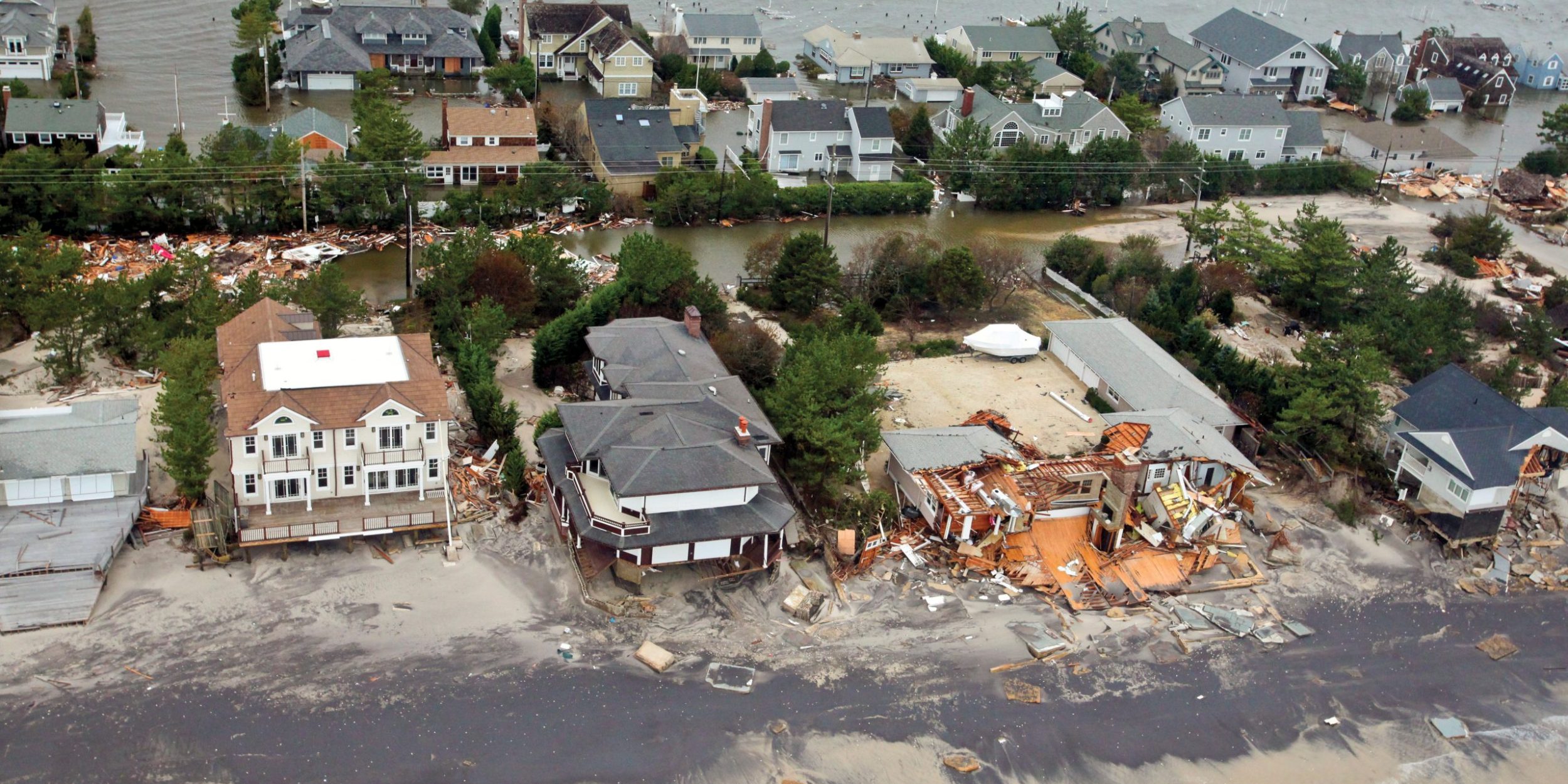

Improving predictions between weather and climate can help prepare communities for impacts from extremes like Hurricane Sandy and other tropical cyclones. This aerial image shows some of the damage from Hurricane Sandy. Credit: Master Sgt. Mark C. Olsen/U.S. Air Force
Meteorologists can tell you whether it will storm 10 days before your wedding, and climatologists can determine if you’re likely to have a hot and dry summer almost a year in advance. But the time period from two weeks to a season, known as the subseasonal to seasonal (S2S) timescale, has remained a major weather-climate prediction gap despite growing public demand.
Given this heightened interest both internationally and in the U.S., three leaders from the weather and climate research communities share their perspective on how best to address this challenge in a new open-access paper in Nature Partner Journals – Climate and Atmospheric Science. The authors include Annarita Mariotti, Director of the NOAA MAPP Program, as well as Paolo Ruti and Michel Rixen, who coordinate research for the World Weather Research Program (WWRP) and World Climate Research Program (WCRP), respectively.
While scientists have made significant progress in recent years, the authors emphasize that both weather and climate groups must work together to successfully bridge the S2S prediction gap.
“A lack of engagement from either side would result in slower and more costly progress,” said Mariotti, lead author of the paper.
Combining the strengths of both communities
Historically, the weather and climate research communities have worked separately from each other because of the different atmospheric dynamics at play in these distinct timescales. But the S2S timescale is in between, and can’t rely solely on weather or climate prediction.
“Neither [weather or climate methods] is perfectly suited for S2S prediction,” said Rixen.
For weather models, scientists focus primarily on representing atmospheric processes that include descriptions of weather conditions at the beginning of the forecast. Climate models, on the other hand, take interactions between the atmosphere, the ocean, and the land into consideration. These components change more slowly and can help guide how the atmosphere may evolve over longer timescales. However, these added complexities take more computing power, so climate models include fewer details about atmospheric dynamics.


At different lead times (horizontal axis), different parts of the Earth’s climate system (atmosphere, purple; land surface, green; ocean, blue) become more or less important to forecast skill (vertical axis). For short lead times, knowing the initial state of the atmosphere counts the most. At 2- to 4-week lead times, knowledge of the land surface is also needed, including things like soil moisture, snow cover, and vegetation. Forecasting more than 30 days ahead typically requires knowledge of the ocean, such as the sea surface temperature variations linked to El Niño. Credit: NOAA Climate.gov graphic, adapted from original by Paul Dirmeyer.
Since neither approach is directly applicable to the S2S timescale, scientists have started to fuse the best techniques from both weather and climate forecasting to bridge the prediction gap and provide “seamless” predictions across the weather-climate continuum. Climate modelers are now using higher resolution and more sophisticated representations of atmospheric processes that better depict the initial state of the atmosphere. Alternatively, weather modelers are now incorporating interactions between the atmosphere and other Earth system components. In addition, research has increasingly shown how slower evolving climate processes can influence weather and the likelihood of extreme events, further linking the two timescales.
“Significant progress has been achieved by integrating the weather and climate communities and leveraging their respective strengths, otherwise not achieved by only separate developments,” said Ruti.
Fostering future progress
Going forward, the authors note that continued collaboration is crucial. Fortunately, there are national and international programs already in place that draw from the best of the weather and climate communities to facilitate joint efforts.
The WWRP and the WCRP created the international S2S Prediction Project with the goal to bring the weather and climate communities together and bridge the prediction gap. This effort motivated other research initiatives such as the NOAA MAPP Program’s S2S Prediction Task Force, co-supported by the National Weather Service and other agencies, which coordinates weather and climate scientists funded by the Program to rapidly advance research goals and objectives. Mariotti ideally wants to see the current weather and climate programs contributing to the next 5 year phase of the S2S Prediction Project to sustain and enhance this effort.


This figure illustrates the S2S or weather-climate prediction gap. It shows estimated forecast skill based on how far ahead the forecast is issued, as well as the types of phenomena being predicted for each time range. Going from weather to seasonal forecasts, prediction skill decreases. Much less is known about forecast skill and predictability sources in the S2S range, 2 week up to a season. Credit: NOAA CPO graphic adapted from original by Elisabeth Gawthrop and Tony Barnston, IRI.
“It will be important to further capitalize on the expertise of the weather and climate research communities to improve [S2S] prediction skill, to promote the initiative’s uptake by operational centers, and fundamentally to build a more seamless research-to-operations framework,” said Ruti and Rixen.
The paper is published in the open-access, online-only journal “NPJ Climate and Atmospheric Science” and can be read in full by visiting https://www.nature.com/articles/s41612-018-0014-z.
About MAPP
The Modeling, Analysis, Predictions, and Projections (MAPP) Program is a competitive research program in NOAA Research’s Climate Program Office. MAPP’s mission is to enhance the Nation’s and NOAA’s capability to understand, predict, and project variability and long-term changes in Earth’s system and mitigate human and economic impacts. To achieve its mission, MAPP supports foundational research, transition of research to applications, and engagement across other parts of NOAA, among partner agencies, and with the external research community. MAPP plays a crucial role in enabling national preparedness for extreme events like drought and longer-term climate changes. For more information, please visit www.cpo.noaa.gov/MAPP.
View More MAPP News.



